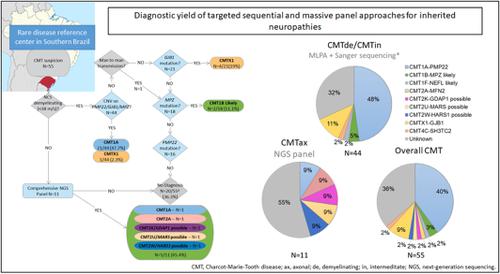当前位置:
X-MOL 学术
›
Clin. Genet.
›
论文详情
Our official English website, www.x-mol.net, welcomes your
feedback! (Note: you will need to create a separate account there.)
Diagnostic yield of targeted sequential and massive panel approaches for inherited neuropathies.
Clinical Genetics ( IF 2.9 ) Pub Date : 2020-06-07 , DOI: 10.1111/cge.13793 Janice Pacheco Dias Padilha 1, 2 , Carolina Serpa Brasil 3 , Alice Maria Luderitz Hoefel 1, 4 , Pablo Brea Winckler 1, 4, 5 , Karina Carvalho Donis 3, 4, 6 , Ana Carolina Brusius-Facchin 1, 3 , Jonas Alex Morales Saute 1, 2, 3, 4, 5, 7
Clinical Genetics ( IF 2.9 ) Pub Date : 2020-06-07 , DOI: 10.1111/cge.13793 Janice Pacheco Dias Padilha 1, 2 , Carolina Serpa Brasil 3 , Alice Maria Luderitz Hoefel 1, 4 , Pablo Brea Winckler 1, 4, 5 , Karina Carvalho Donis 3, 4, 6 , Ana Carolina Brusius-Facchin 1, 3 , Jonas Alex Morales Saute 1, 2, 3, 4, 5, 7
Affiliation

|
Diagnostic yield of genetic studies for Charcot‐Marie‐Tooth disease (CMT) is little known, with a lack of epidemiological data to build better diagnostic strategies outside the United States and Europe. We aimed to evaluate the performance of two molecular diagnostic strategies for patients with CMT, and to characterize epidemiological findings of these conditions in southern Brazil. We performed a single‐center cross‐sectional study, in which 94 patients (55 families) with CMT suspicion were evaluated. Overall, the diagnostic yield of the combined strategy of Multiplex‐ligation‐dependent‐probe‐amplification (MLPA) of PMP22/GJB1/MPZ and GJB1/MPZ/PMP22 Sanger sequencing was 63.6% (28/44) for index cases with demyelinating/intermediate CMT suspicion (21 CMT1A‐PMP22 , 5 CMTX1‐GJB1 and 2 with probably CMT1B‐MPZ diagnosis). Five of the 11 index cases (45.4%) with axonal CMT had at least a possible diagnosis with next generation sequencing (NGS) panel of 104 inherited neuropathies‐related genes (one each with CMT1A‐PMP22 , CMT2A‐MFN2 , CMT2K‐GDAP1 , CMT2U‐MARS , CMT2W‐HARS1 ). Detailed clinical, neurophysiological and molecular data of families are provided. Sequential molecular diagnosis strategies with MLPA plus target Sanger sequencing for demyelinating/intermediate CMT had high diagnostic yield, and almost half of axonal CMT families had at least a possible diagnosis with the comprehensive NGS panel. Most frequent subtypes of CMT in our region are CMT1A‐PMP22 and CMTX1‐GJB1 .
中文翻译:

针对遗传性神经病的靶向顺序和大规模面板方法的诊断率。
夏科-马里-图思病 (CMT) 基因研究的诊断率鲜为人知,因为缺乏流行病学数据来制定美国和欧洲以外更好的诊断策略。我们的目的是评估两种分子诊断策略对 CMT 患者的效果,并描述巴西南部这些疾病的流行病学结果。我们进行了一项单中心横断面研究,对 94 名疑似 CMT 的患者(55 个家庭)进行了评估。总体而言, PMP22/GJB1/MPZ和GJB1/MPZ/PMP22 Sanger 测序的多重连接依赖性探针扩增 (MLPA) 组合策略对于脱髓鞘/脱髓鞘的指标病例的诊断率为 63.6% (28/44)。中间 CMT 怀疑(21 个 CMT1A- PMP22、5个 CMTX1 -GJB1和 2 个可能具有 CMT1B- MPZ诊断)。 11 例轴突 CMT 指标病例中,有 5 例 (45.4%) 至少通过下一代测序 (NGS) 组 104 个遗传性神经病相关基因(CMT1A- PMP22 、CMT2A- MFN2 、CMT2K-GDAP1、CMT2K- GDAP1各一个)进行了可能的诊断。 CMT2U- MARS 、CMT2W- HARS1 )。提供了家庭的详细临床、神经生理学和分子数据。使用 MLPA 加上目标桑格测序进行脱髓鞘/中间 CMT 的序列分子诊断策略具有较高的诊断率,几乎一半的轴突 CMT 家族至少通过综合 NGS 组合进行了可能的诊断。我们地区最常见的 CMT 亚型是 CMT1A- PMP22和 CMTX1- GJB1 。
更新日期:2020-07-15
中文翻译:

针对遗传性神经病的靶向顺序和大规模面板方法的诊断率。
夏科-马里-图思病 (CMT) 基因研究的诊断率鲜为人知,因为缺乏流行病学数据来制定美国和欧洲以外更好的诊断策略。我们的目的是评估两种分子诊断策略对 CMT 患者的效果,并描述巴西南部这些疾病的流行病学结果。我们进行了一项单中心横断面研究,对 94 名疑似 CMT 的患者(55 个家庭)进行了评估。总体而言, PMP22/GJB1/MPZ和GJB1/MPZ/PMP22 Sanger 测序的多重连接依赖性探针扩增 (MLPA) 组合策略对于脱髓鞘/脱髓鞘的指标病例的诊断率为 63.6% (28/44)。中间 CMT 怀疑(21 个 CMT1A- PMP22、5个 CMTX1 -GJB1和 2 个可能具有 CMT1B- MPZ诊断)。 11 例轴突 CMT 指标病例中,有 5 例 (45.4%) 至少通过下一代测序 (NGS) 组 104 个遗传性神经病相关基因(CMT1A- PMP22 、CMT2A- MFN2 、CMT2K-GDAP1、CMT2K- GDAP1各一个)进行了可能的诊断。 CMT2U- MARS 、CMT2W- HARS1 )。提供了家庭的详细临床、神经生理学和分子数据。使用 MLPA 加上目标桑格测序进行脱髓鞘/中间 CMT 的序列分子诊断策略具有较高的诊断率,几乎一半的轴突 CMT 家族至少通过综合 NGS 组合进行了可能的诊断。我们地区最常见的 CMT 亚型是 CMT1A- PMP22和 CMTX1- GJB1 。











































 京公网安备 11010802027423号
京公网安备 11010802027423号